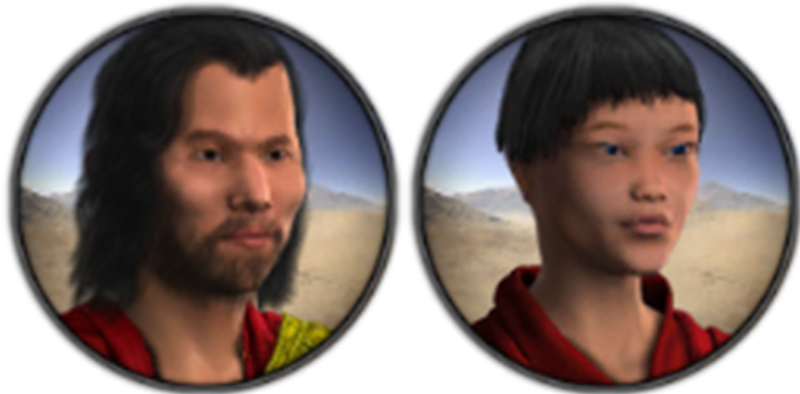Rakṣaka
The Keepers of the Lost City
Eking out a meager existence in the Uul Mountains, the Rakṣaka are all that remain of a once noble people. Many centuries ago, the Uul Mountains sat at the heart of a thriving kingdom, complete with technological marvels, rich art and a government headed by the magnificent Rakṣaka Rājā and their powerful priests, the Mahāna pūjāhārī. However, with the eruption of Mana Nui at the end of the Age of Light, all that changed. As the Uul Mountains were blanketed by ash, the mighty kingdom fell into anarchy. The glory days long since past, those Rakṣaka who still remain within the Uul Mountains practice a life of requisite simplicity around the ruins of the old capital, Mandira.
Naming Traditions
Unisex names
Bhuti, Choenyi, Chokphel, Dawa, Dhundup, Dolma, Gurung, Gyatso, Gyurmey, Jampa, Jangchup, Khando, Kunchok, Kunga, Lhawang, Lekhshey, Lhakpa, Metok, Namdak, Norbu, Nyima, Passang, Pema, Phuntsok, Rabten, Rigsang, Sangyal, Sujal, Sonam, Tashi, Tenzin, Tsundue, Woeser, Woeten, Wangyag
Family names
Acharya, Adhikari, Bhandari, Bhattarai, Karki, Khadka, Lama, Rai, Sakya, Shrestha, Thapa
Culture
Culture and cultural heritage
A crumbling ensemble of monuments hint at the existence of a great Rakṣaka kingdom nestled within the Uul Mountains before the Age of Ash. Ruined castles loom over small pastoral camps, old temples rest in hidden nooks and ancient tombs lie long forgotten among the mountain peaks. The Rakṣaka were all but wiped from the pages of history by the eruption of Mana Nui three centuries ago. As chaos descended upon the outer provinces of their realm, the Mahāna pūjāhārī of the Mandira Valley sought to preserve what little they could of their ancient wisdom, retreating to their fortified monastery high above the palace of the Rājā. When they emerged over eighteen years later, much of the kingdom had fallen to ruin. Doing their best to assist those who survived, the pūjāhārī soon regained some of their former social standing, and reintroduced some of the culture that had been lost to the Rakṣaka, but the true glory of the old kingdom lies forever buried in dust and ash.
Common Dress code
The staple item of clothing traditionally worn by the Rakṣaka people is a broad woolen robe, which is fastened under the right arm with two cloth belts. Beneath this robe, a long sleeved shirt is also fastened on the right side. To ward off the cold, many Rakṣakas wear coats and hats of animal fur over the top of their robes. Beneath, wooden sandals are tied to the feet with cloth wraps.
Art & Architecture
Many of the fortresses and temples of the old kingdom were built entirely of stone, using heavy rock pillars to support domed stone roofs. Now, most Rakṣaka live in large felt tents, supported by frames of wood or bone. They generally follow their animals between grazing lands, and it is rare for any beside the Mahāna pūjāhārī to live within fixed dwellings.
Common Taboos
Scattered around the Uul Mountains, it is quite common to find old trinkets or jewellery left over from the old kingdom. Elegantly worked from gold, silver, copper, or tin, few Rakṣaka will ever touch these treasures, and none would ever consider wearing such things. The Mahāna pūjāhārī believe that the kings of the past's obsession with opulence contributed in no small way to the collapse of the old world. So as they emerged from their Mandira monastery and saw their kinsfolk begging for scraps amidst the ash, the elders vowed that the Rakṣaka would lust after such signs of wealth no longer.
Common Myths and Legends
Pūjāhārī scriptures tell the tale of lha-mognam, the patron deity of the Rakṣaka people. According to legend, lha-mognam arose from a great sihiri crystal, buried in the heart of Kang-ri Oya. This spectacular crystal was brought to the Uul Mountains by the first settlers over nine millennia ago. There it was kept, undisturbed in the caverns beneath the towering peaks, until it was unearthed by the Mahāna pūjāhārī, five thousand years later. The priests used their power to unlock the full potential of the sihiri, by freeing lha-mognam from her crystalline enclosure. The first civilization to harness the power of a sihiri crystal in this way, the Rakṣaka reaped the benefits of lha-mognam's divine blessing for generations to come. Able to communicate directly with the demigod, the Rakṣaka did not have to rely on only vague interpretations of their whims and wishes being fulfilled, and the Rājās wielded a much more controlled form of magic during their reign. However, as the Age of Light drew to a close, lha-mognam grew anxious as she sensed the fabric of the world stretching thin, and eventually she retreated back to Kang-ri Oya, sealing herself back within her crystal home to wait out the coming storm.
Ideals
Beauty Ideals
The Rakṣaka people are small in stature and light on their feet. With slender builds, they rarely stand above five feet tall and are often regarded as weak by their more burly Uja Oran neighbours. The Rakṣaka's eyes are dark in colour and their hair ranges from black to very dark brown. Hair is worn straight and tends to be cut level with the tops of the ears, although it is customary for the pūjāhārī to grow their hair longer, shaving and trimming one's hair being seen to lie upon the path to extravagance.
Parent ethnicities
Related Locations
Remove these ads. Join the Worldbuilders Guild











Comments